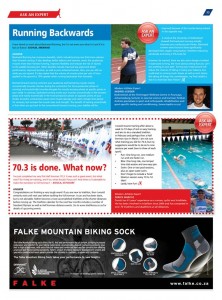Ask an Expert: Backwards Running
Posted on February 6th, 2012 by Andries
By Andries Lodder for Modern Athlete Magazine Feb 2012 Issue

Backwards Running: Fact or Fiction?
Question:
I have heard so much about Backwards Running, but I’m not even sure what it is and if it is a fact or fiction.
Answer:
During locomotion the most involved joint of the lower body is the patello-femoral joint. Forming part of this joint is the patella, which is a sesamoid bone which reduces patello-femoral stresses, as well as increases the lever arm of the quadriceps muscles. The quadriceps muscle is the dynamic stabilizer of the patello-femoral joint. This joint is also the most common site for anterior knee pain, contributed by weakness of the quadriceps muscle.
Backwards running has numerous benefits which include burning one third more calories than forward running, it also develops better balance and stamina, it works the quadriceps muscles more than forward running, improves flexibility, reduces risk of injuries to the patello-femoral joint, you can still run while you are injured, improve leg speed and better performance, improved posture as well as your senses will be enhanced. It’s also stated that the volume of muscle active per unit of force applied to the ground was 10% greater when running backward than forward.
Normal forwards running contracts your muscles (quadriceps and hamstrings) mainly concentrically (muscles shorten during the contraction for force production phase of running) and eccentrically (muscles elongates for muscle recovery phase) at specific points in your stride. Backwards running works your muscles concentrically (recovery phase) and mainly eccentrically (force production phase) at opposite points of your strides. Eccentric contractions cause more muscle damage and needs a longer time period for recovery, but increases the muscle mass and strength. The benefit of training eccentrically is that when you go back to the conventional forwards running, your stability will be improved because of the muscles being trained in the opposite way and therefore your opposing muscle groups will provide some contraction while they are supposed to be relaxed, to provide more support to the contracting agonistic muscle.
A study at Stellenbosch University showed that the technique of backwards running actually improved your cardiovascular fitness. They used female students over a six-week period, training three times a week compared with a female group that stuck with their normal training regimes. The findings of the study were that the backward runners were found to have significantly decreased their oxygen consumption, therefore improving aerobically and lost 2.5% body fat.
Dangers of backwards running also exist. One of them is that when running backwards you can’t see anything in front of you or in the way of your path. Turning your head around will reduce the chances of falling or loosing your balance, but could lead towards running much slower as well as increase neck strains.
Considering the benefits and the biomechanics behind the patello-femoral joint, backwards running would reduce the occurrence of patello-femoral joint pain due to the strengthening of the quadriceps and the increased flexibility, which corresponds to the rehabilitation for treatment of anterior knee pain including hamstring stretching and VMO (vastus medialis oblique) strengthening.
Therefore my final verdict is that it is more fact than fiction.
To read this article on the Modern Athlete webpage, follow link: Ask an Expert: Backwards Running or buy the Feb issue today
Tweet